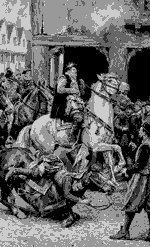







Copyright (c) 1998
Royal Stuarts
All Rights Reserved
Royal Stuarts
All Rights Reserved
|
Murder of Moray
Regent of Scotland 1567-1570 from
|

|
The Hamilton party had determined to put Moray to death, and the affair was undertaken by one of themselves, James Hamilton, commonly called "Bothwellhaugh." A story converting this well-planned murder into a frantic act of retribution for certain deeds of fiendish cruelty has found its way into ordinary history, though it bears on its face the palpable characteristics of romance.
As the story goes, Hamilton had made a sacrifice of his paternal estate of Bothwellhaugh in his loyalty to his queen, by fighting for her at Langside, and so falling to be dealt with by that law of treason which the victor ever has at his command. His wife was heiress of the pleasant domain of Woodhouselee, and this he believed to be safe from the perils following his imprudent loyalty. He was mistaken. Woodhouselee was forfeited to enrich a greedy favourite of the regent; and the new-comer seized on his spoil with such heartless rapacity, that although the wife of Bothwellhaugh was enduring that ordeal which gives woman the strongest claim on the sympathy of man, he drove her forth on a winter night with her infant, to wander along the bleak hillside until death came to her relief. Some transactions there were about lands which Bothwellhaugh enjoyed in right of his wife; but the nature of these transactions gives them the aspect of a family arrangement to preserve them from forfeiture for treason committed by Bothwellhaugh. But if this be not absolutely proved, another fact is sufficient for the extinction of the fable that the lady was afterwards living at Bothwellhaugh while her husband was a fugitive for the murder of the regent.
On the 23d of February 1570, Bothwellhaugh's opportunity came. The regent, on his way from Stirling to Edinburgh, was then to ride in state through Linlithgow. The Hamiltons had a strong feudal influence in the surrounding district, and could thus make their preparations among themselves. The structure of the old Scots towns favoured such a deed. They were generally laid out in one narrow street, with gardens radiating outwards on either side. These the enemy might destroy; but the backs of the houses formed a sort of wall and protected the actual town from invasion. The arrangement was conducive to, health as well as protection; but it afforded opportunities for mischief, and frequently those concerned in street-brawls could escape through their own houses into the open country. A house, belonging, according to the concurring testimony of contemporaries, to Archbishop Hamilton, was found to suit the purpose, as facing the principal street. Horses and all other, means were ready for escape westward into the chief territory of the Hamiltons, where they were absolute. There was a balcony in front with hangings on it. Perhaps the citizens did honour to the occasion by displaying their finery, and this house appeared to be decorated like the others. We hear of warnings of his danger having reached the ear of the regent; but he was not a man easily flustered or alarmed, and took no further heed to what was said save that he thought it prudent to pass rapidly forward. In this, however, he was impeded by the crowd. The murderer had to deal with the delays and difficulties of the clumsy hackbut of the day; but he did his work to perfection. "The bullet passed through the body between the waist and the thigh, and retained impetus enough to kill a horse near the regent's side. He remained some hours alive; but he knew his fate, and met it with the calm bravery of his nature. ----------------------------------------------------------
If those who planned the murder of the regent expected from it a great disorganisation, giving opportunities to desperate men, they were quite correct; and their act was a judicious one according to their political code. Except that of the royal infant, there was no other life in Scotland so well worth taking. The news flew over Europe. To the English Government the event was a heavy blow. In Spain it was received with decorous satisfaction, as one of the steps by which the inscrutable decrees of Providence were to restore the Church. In France it excited wild delight in the party of the Guises. They had a representative nearer home by whom their exultation was shared. It broke in on the monotony of Queen Mary's prison-life with a welcome and joyous excitement, proving, indeed, one of those occasions on which passion overcame her fine sense of decorum and good feeling. In a long letter to Beaton, the Archbishop of Glasgow, whom she counted her ambassador in France, she states that Bothwellhaugh did not do the deed by her order. Here she might well have stopped, but with a kind of ferocious candour she goes on to say that for that reason she is the more indebted to him for doing it. She expects an intimation that her jointure as Queen-Dowager of France is available ; and in the scheme of distribution she will riot forget Bothwellhaugh's pension, which she speaks of as the fulfilment of a promise. It was naturally believed at the time that she knew and authorised the deed, and it was asserted by Randolph that a similar fate would befall the Queen of England if those about her failed in due vigilance.
* - certain edits to the original text have been made for clarity



